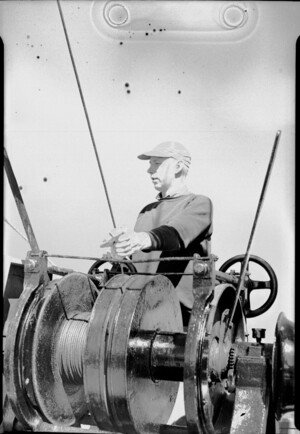As the MBL grew in size, bigger tools and more advanced methods were employed to amass the specimens necessary for research. Collecting vessels were built, collectors were employed, and the vessels were stocked with a variety of tools that aided in larger scale and deeper water collecting. One example of these larger tools is the dredge, a large metal net that is dragged along the ocean floor behind a boat.
Because it is made out of metal, the dredge is quite heavy and requires a winch to deploy it properly. Once the dredge is deployed, the crew allows it to drag along the seafloor for a few moments to amass a good quantity of organisms. Then the dredge is pulled up and its contents are dumped on the deck of the ship for examination. This is always an exciting time, almost like bursting open a pinata, because dredge samples are often full of surprises and you never know what you might get. What appears on the boat deck is an amalgamation of different marine organisms--one dredging might produce a mixture of sea urchins, hermit crabs, and even baby lobsters. Once the bounty is dumped on the deck, some of the creatures begin to scurry away!
Dredging is a collecting method that has stood the test of time; beginning at the MBL in the 19th century, it is still used on a daily basis. Other smaller tools aboard collecting vessels supplement the finds from the seafloor. For example, samplers can be held over the edge of the boat to gather organisms that hang out higher in the waters.
- Dolgin, Elie, “The Squid Collector,” http://www.nature.com/news/not-your-average-technician-1.16785
- “John J. Valois, Obituary” http://www.mbl.edu/obituaries/john-j-valois/
- “John Valois, Longtime Specimen Collector and Naturalist, Honored at the Marine Biological Laboratory,” July 12, 2011, http://hermes.mbl.edu/news/press_releases/2011/2011_pr_07_12.html
- The Collecting Net Spring 2006, Vol. 2, No. 1 http://hermes.mbl.edu/publications/collecting_net/2006/06_01net06.html Accessed on July 16, 2015.
- Maienschein, Jane, and Ruth Davis. 100 years exploring life, 1888-1988: the Marine Biological Laboratory at Woods Hole. Jones and Bartlett Publishers, 1989.
- “MBL Moment with Dave Remsen,” MBL Catalyst January 2014, p 12-13. http://www.mbl.edu/wp-content/uploads/2013/07/Catalyst.Winter13-14.web_.pdf Accessed on July 16, 2015.
- Williams, Wendy. Kraken: The Curious, Exciting, and Slightly Disturbing Science of Squid. Abrams, 2011.

